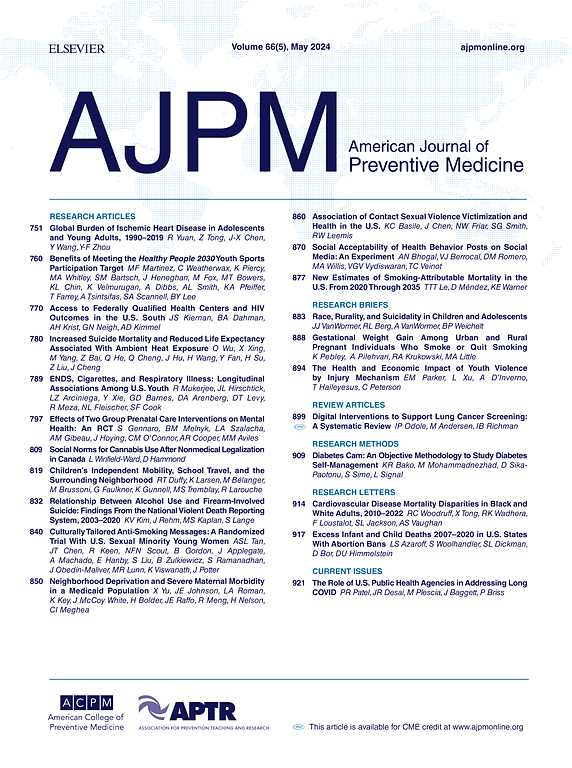Message Evaluation Equivalence in Pre Versus Postproduction Tobacco Education Ads
IF 4.5
2区 医学
Q1 MEDICINE, GENERAL & INTERNAL
引用次数: 0
Abstract
Introduction
The U.S. Food and Drug Administration’s The Real Cost campaigns inform the public about the harms of tobacco use. The U.S. Food and Drug Administration has followed a 2-part approach to advertise formative testing to ensure sufficient audience receptivity: preproduction qualitative testing and postproduction quantitative testing. This process provides safeguards for ad performance but course corrections to message selection or development after the ads are already fully produced can be time and resource intensive. This study assesses equivalence in message evaluations between pre and postproduction campaign ads.
Methods
Data were collected in 2023 from an online panel survey of 804 youth aged 13–17 years, who currently use or are susceptible to use E-cigarettes or cigarettes. Participants were randomly assigned to a set of 4 preproduction or postproduction The Real Cost campaign ads. Participants completed a series of message evaluation measures after each ad. Authors tested for equivalence of mean message evaluation scores between the pre and postproduction versions of each ad using 2 one-sided t-tests and estimated concordance correlation coefficients. Data were analyzed in 2024.
Results
Aggregate ad performance scores between pre and postproduction versions were equivalent. Patterns varied for individual ads, with most demonstrating equivalence on some but not all message evaluation measures. Concordance correlation coefficients for pre and postproduction ads were positive and moderate in size.
Conclusions
Results suggest that message evaluation assessments of preproduction ads are likely a good indicator of message evaluation assessments for postproduction ads. Public health practitioners may consider incorporating quantitative copy testing earlier in the formative testing process to identify the most promising ad concepts.
烟草教育广告前后信息评价的等价性
导言:美国食品和药物管理局的“真实成本”运动向公众宣传烟草使用的危害。美国食品和药物管理局采用了两部分的方法来进行广告形成性测试,以确保足够的受众接受度:制作前定性测试和制作后定量测试。这个过程为广告效果提供了保障,但在广告完全制作完成后,对信息选择或开发的过程进行修正可能会耗费大量时间和资源。本研究评估了广告制作前后信息评估的等效性。方法:数据收集于2023年,来自804名13-17岁青少年的在线小组调查,他们目前使用或容易使用电子烟或香烟。参与者被随机分配到一组4个“真实成本”广告的前期制作或后期制作。参与者在每个广告后完成一系列信息评估措施。作者使用2个单侧t检验和估计的一致性相关系数检验了每个广告制作前后版本的平均信息评价分数的等效性。数据分析于2024年进行。结果:前期和后期版本的广告表现总分相当。个别广告的模式各不相同,大多数广告在某些信息评估指标上表现出相同,但不是所有信息评估指标。广告制作前后的一致性相关系数均为正相关,且大小适中。结论:结果表明,前期广告的信息评价评估可能是后期广告信息评价评估的一个很好的指标。公共卫生从业人员可以考虑在形成性测试过程中更早地纳入定量副本测试,以确定最有希望的广告概念。
本文章由计算机程序翻译,如有差异,请以英文原文为准。
求助全文
约1分钟内获得全文
求助全文
来源期刊

American Journal of Preventive Medicine
医学-公共卫生、环境卫生与职业卫生
CiteScore
8.60
自引率
1.80%
发文量
395
审稿时长
32 days
期刊介绍:
The American Journal of Preventive Medicine is the official journal of the American College of Preventive Medicine and the Association for Prevention Teaching and Research. It publishes articles in the areas of prevention research, teaching, practice and policy. Original research is published on interventions aimed at the prevention of chronic and acute disease and the promotion of individual and community health.
Of particular emphasis are papers that address the primary and secondary prevention of important clinical, behavioral and public health issues such as injury and violence, infectious disease, women''s health, smoking, sedentary behaviors and physical activity, nutrition, diabetes, obesity, and substance use disorders. Papers also address educational initiatives aimed at improving the ability of health professionals to provide effective clinical prevention and public health services. Papers on health services research pertinent to prevention and public health are also published. The journal also publishes official policy statements from the two co-sponsoring organizations, review articles, media reviews, and editorials. Finally, the journal periodically publishes supplements and special theme issues devoted to areas of current interest to the prevention community.
 求助内容:
求助内容: 应助结果提醒方式:
应助结果提醒方式:


